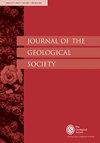走滑对设得兰岛富拉砂岩群地层和构造发育的影响:对英国北部近海泥盆纪盆地发育的启示
IF 3
3区 地球科学
Q2 GEOSCIENCES, MULTIDISCIPLINARY
引用次数: 0
摘要
富拉岛位于设得兰群岛西南25公里处,保留了一个缓慢折叠的1.6公里厚的中泥盆世砂岩序列,壮观地暴露在350米高的一公里长的悬崖部分。这些岩石不整合地覆盖在可能的前寒武纪角闪岩相基底岩石上,被片状花岗岩侵入。陆上继承层的年龄与西部近海附近的Lower Clair Group相似。新的测绘结合了无人机图像在难以接近的悬崖剖面上的使用,使用了下倾投影,表明福拉的生长褶皱和断裂与盆地填充期间的沉积是同时期的。大尺度构造几何形状与中泥盆世沿墙缘-大格伦断裂带系统运动的左旋张拉引起的区域收缩应变一致。碎屑锆石物源研究表明,富拉泥盆纪序列——以及西设得兰群岛附近的梅尔比——与克莱尔群和奥克尼序列相似。我们认为,在苏格兰泥盆纪盆地,与区域沉降同时期的NE-SW张拉褶皱发育可能比以前认为的更为广泛。因此,以前被解释为与二叠纪-石炭纪反转有关的大型公里尺度褶皱可能在盆地演化中比以前认识到的更早开始。补充资料:https://doi.org/10.6084/m9.figshare.c.6442552本文章由计算机程序翻译,如有差异,请以英文原文为准。
The strike-slip influenced stratigraphic and structural development of the Foula Sandstone Group, Shetland: implications for offshore Devonian basin development in the northern UKCS
The island of Foula located 25 km SW of Shetland preserves a gently folded, 1.6 km thick sequence of Middle Devonian sandstones spectacularly exposed in kilometre-long cliff sections over 350 m high. These rocks unconformably overlie likely Precambrian-age amphibolite facies basement rocks, intruded by sheeted granites. The onshore succession is similar in age to the nearby Lower Clair Group offshore to the west. New mapping which incorporates use of drone imagery in inaccessible cliff sections uses down-plunge projections to show that growth folding and faulting on Foula were contemporaneous with sedimentation during basin filling. The large-scale structural geometry is consistent with regional constrictional strain due to sinistral transtension associated with movements along the Walls Boundary - Great Glen Fault Zone system during the Middle Devonian. Detrital zircon provenance studies indicate that the Devonian sequences of Foula - and nearby Melby in western Shetland - show similarities with the Clair Group and Orkney successions. We suggest that NE-SW transtensional fold development contemporaneous with regional subsidence may be more widespread than previously realised in the Devonian basins of Scotland. Large, kilometre-scale folds previously interpreted to be related to Permo-Carboniferous inversion may therefore have initiated earlier in the basin evolution than previously realised.
Supplementary material:
https://doi.org/10.6084/m9.figshare.c.6442552
求助全文
通过发布文献求助,成功后即可免费获取论文全文。
去求助
来源期刊

Journal of the Geological Society
地学-地球科学综合
CiteScore
6.00
自引率
3.70%
发文量
68
审稿时长
6-12 weeks
期刊介绍:
Journal of the Geological Society (JGS) is owned and published by the Geological Society of London.
JGS publishes topical, high-quality recent research across the full range of Earth Sciences. Papers are interdisciplinary in nature and emphasize the development of an understanding of fundamental geological processes. Broad interest articles that refer to regional studies, but which extend beyond their geographical context are also welcomed.
Each year JGS presents the ‘JGS Early Career Award'' for papers published in the journal, which rewards the writing of well-written, exciting papers from early career geologists.
The journal publishes research and invited review articles, discussion papers and thematic sets.
 求助内容:
求助内容: 应助结果提醒方式:
应助结果提醒方式:


